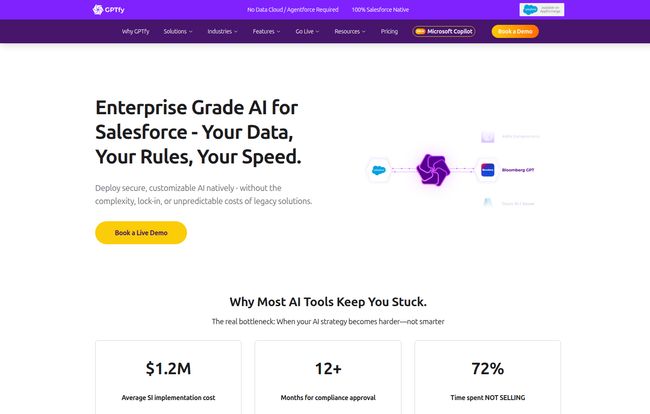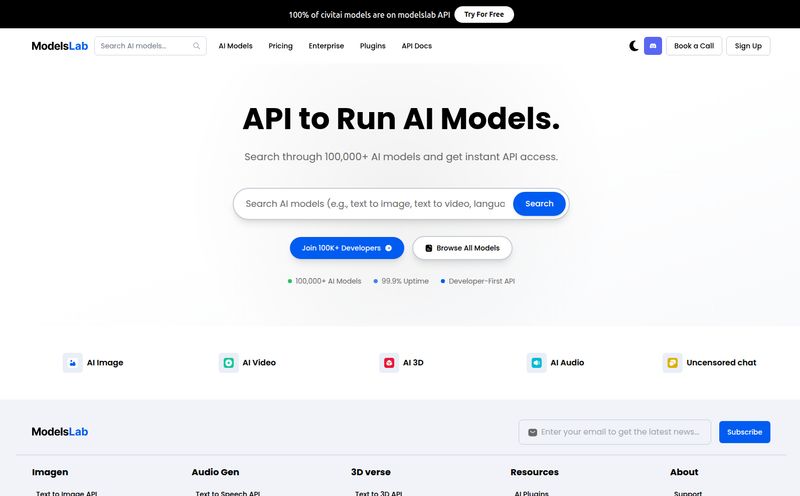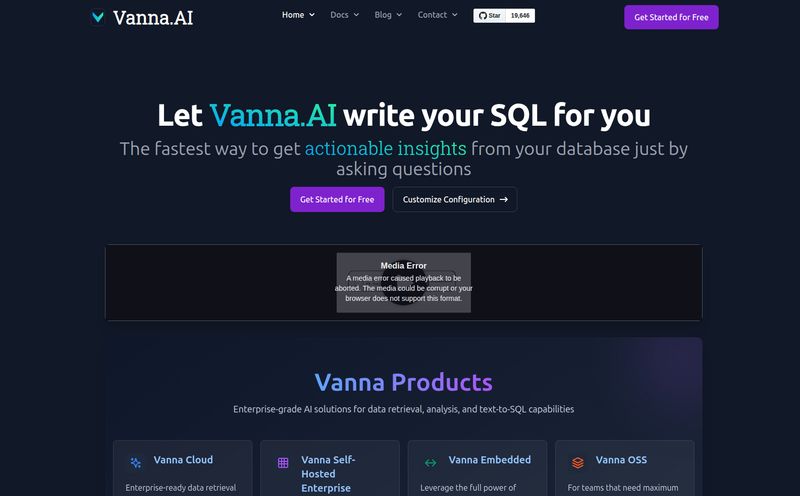For the past couple of years, the firehose of AI hype has been pointed directly at our faces. "Revolutionize your workflow!" "Automate everything!" "Generate leads while you sleep!" We've all heard it. And as someone who's been around the block in the SEO and digital marketing world, my B.S. meter starts twitching when the promises get that big.
The reality of plugging these powerful new AI tools into a beast like Salesforce is often… messy. It can feel like you're performing open-heart surgery on your CRM with a butter knife. You worry about data security, your data being shipped off to some third-party cloud, insane implementation costs, and a final product that your team can't even figure out how to use. It’s a classic case of the cure being worse than the disease.
So, when I came across a platform called GPTfy, my initial skepticism was on high alert. But then I saw two words that made me lean in closer: 100% Salesforce Native. Okay, now you have my attention.
What's the Big Deal About 'Salesforce Native' Anyway?
If you're not deep in the Salesforce ecosystem, "native" might sound like just another piece of marketing jargon. It's not. It's arguably the most important feature of a tool like this.
Think of it this way. Integrating a non-native app into Salesforce is like parking a trailer in your backyard. Sure, it gives you more space, but you have to run a long extension cord, it looks out of place, and you're always a little worried about the security. A native Salesforce app, on the other hand, is like building a proper extension on your house. It uses the same foundation, the same electrical wiring, and the same security system. It’s part of the structure. It just works.
For businesses, especially in regulated industries like finance or healthcare, this is everything. GPTfy being Salesforce Native means your data—your precious, confidential customer data—never leaves the Salesforce Trust Layer. There's no separate "Agent Cloud" or data processing happening on some unknown server. It all stays within the fortified walls of your existing Salesforce org. That single point makes a world of difference for compliance, security, and frankly, my peace of mind.

Visit GPTfy
A Look Under the Hood: GPTfy's Key Features
So it's secure. Check. But what can it actually do? I've seen plenty of secure tools that were about as useful as a screen door on a submarine. Luckily, GPTfy seems to have packed in some genuinely thoughtful features.
Bring Your Own Model (BYOM): No More AI Vendor Lock-In
This is a big one. GPTfy doesn't force you into a single AI model. They have what they call a "Bring Your Own Model" approach. This means you can connect to OpenAI’s GPT-4, Anthropic’s Claude, Google's models, or even your own privately-hosted models through Microsoft Azure. This flexibility is fantastic because the AI world moves incredibly fast. The best model today might not be the best one six months from now. BYOM future-proofs your investment and lets you pick the right tool for the right job.
RAG: Making Your AI Actually Smart About Your Business
Ever ask an AI a question and get a generic, Wikipedia-style answer? That's useless for business. GPTfy uses Retrieval-Augmented Generation (RAG), which is a fancy way of saying it grounds the AI in your company's actual data. Before generating an answer, it can securely read your Salesforce Knowledge articles, past cases, or other internal documents. The result? Instead of a generic reply, your service agent gets a draft that references your specific return policy or troubleshooting steps. It makes the AI contextually aware, which is the difference between a gimmick and a productivity powerhouse.
For the Coder and the Clicker
I appreciate that they've built this for two different types of users. For the everyday sales or service manager, there's a click/no-code Prompt Builder. You can create and deploy complex AI-powered workflows without writing a single line of code. But they haven't forgotten the developers. For the heavy lifters and custom-solution crowd, there's full integration with Salesforce Flow and Apex. This means your technical team can wire GPTfy into the very fabric of your most complex, bespoke processes.
Who is This Really For? (And What Does It Cost?)
Alright, let's get down to brass tacks. This is where you separate the enterprise-grade tools from the SMB players. Looking at the GPTfy pricing page, it's immediately clear who they're talking to. Let's be real, this isnt a tool for a small team or a solopreneur.
Here’s a simplified breakdown:
| Plan | Price Per User/Month | Key Detail |
|---|---|---|
| PRO | $20 | Essential features to get started |
| ENTERPRISE | $30 | The most popular tier, with advanced features |
| UNLIMITED | $50 | All features, plus future add-ons |
Looks reasonable, right? But here's the kicker: every plan has a minimum pricing of $50,000 per year. This is the most important piece of information on the page. GPTfy is positioning itself as a serious, strategic investment for mid-market and enterprise companies that have the scale to justify the cost. If you're a 10-person sales team, this probably isn't for you. If you're a 200-person service center drowning in tickets, that $50k could deliver a massive ROI very, very quickly.
The Not-So-Fine Print
No tool is perfect, and it's important to go in with eyes open. The biggest hurdle, obviously, is that entry price. It's a significant commitment that will require a solid business case and buy-in from leadership.
Secondly, while they tout the no-code builders, the website does hint that some of the deeper integrations might require technical expertise. That's fair. If you want to build something truly custom with Apex, you're going to need someone who knows Apex. It’s not a magic wand, but a powerful toolset for people who know how to wield it.
Putting it All Together: A Day in the Life
Let's move away from features and talk about feel. Imagine your top sales rep. She spends two hours every morning just updating Salesforce records, writing follow-up emails, and summarizing her calls from the day before. It's grunt work that she hates.
Now, with a tool like GPTfy, her workflow changes. She finishes a call, and a summary is already drafted for her review. She clicks a button to generate a personalized follow-up email based on the call transcript and the customer's history. The opportunity record in Sales Cloud gets updated automatically with the key takeaways. Those two hours of admin drudgery just shrank to 15 minutes of review and approval. That's more time for, you know, actually selling. That's the promise, and from what I can see, GPTfy has built the infrastructure to actually deliver on it.
In the end, the mad rush for AI is starting to calm down and people are beginning to ask the hard questions. It's not just about what an AI can do, but how it does it. How secure is it? How well does it integrate? How does it actually make my team's life easier inside the tools they already use every single day?
GPTfy seems to have been built with these questions in mind from the ground up. By wrapping powerful AI capabilities inside the trusted, native Salesforce environment, they've created something that feels less like a risky experiment and more like a logical, powerful next step for any large organization running on Salesforce.
Frequently Asked Questions about GPTfy
- Is GPTfy really 100% Salesforce Native?
- Yes. According to all their documentation, the application is built entirely within the Salesforce infrastructure. This means no external data clouds are needed and your data never leaves the Salesforce Trust Layer, which is a huge plus for security and compliance.
- What AI models can I use with GPTfy?
- GPTfy features a "Bring Your Own Model" (BYOM) architecture. You can connect to leading models from OpenAI, Anthropic (Claude), Google, and others. It also supports private models hosted on platforms like Azure AI.
- Is GPTfy secure for sensitive industries like finance or healthcare?
- Because it's Salesforce Native, it inherits all of Salesforce's security and compliance features. This makes it a much safer choice for industries with strict data-handling requirements, as the data processing happens within your own secure Salesforce environment.
- What's the minimum investment to get started with GPTfy?
- While the per-user pricing is competitive, there is a minimum annual contract value of $50,000. This positions GPTfy as a solution for mid-market and enterprise-level companies.
- Do I need a team of developers to use GPTfy?
- Not necessarily for the core features. GPTfy includes no-code tools like a Prompt Builder that allow non-technical users to create and manage AI workflows. However, for highly customized or complex integrations, you would benefit from having access to a Salesforce developer who can use the Apex and Flow integrations.



